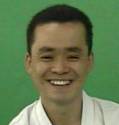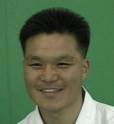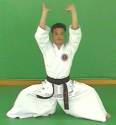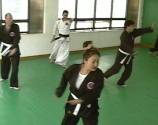Koreabridge.net
- Blogs
- Business Listings
- Classifieds
- Event Calendar
- FAQ
- Forums
- Job Ads
- Photos
- Podcasts
- Polls
- RSS Feeds
- Search
- Videos
- Weblinks
- Recent posts
- Popular Content
- Contact


|
Hapkido Master Coach & Owner of Sun-mukwan & Lee Seung Do Master Yoon's Assistant |

|
 |
 |
 |
 |
To contact Master Yoon
Cell: 010-4538-7087
Email: [email protected]
Website: http://masteryoonshapkido.com
Facebook group: Master Yoon's English Hapkido
English Interview Transcript
Hello! I’m Seung Do Lee. I exercise and assist at the Sun-Mu-Kwan.
QUESTION 1: What is hapkido?
MASTER YOON: I think hapkido is, well, that’s both easy and hard to say. There are many hapkido training centers (halls). Anyway, people think hapkido is a fierce military art, but that’s simply not true. Hapkido is based on circular motion and it’s very smooth.QUESTION 2: Hapkido came from Japan to Korea. When did it come to Korea and how is it different from Japanese “hapkido” (aikido)?Hapki means harmony between two spirits (“ki”) which encounter each other. Hapkido, then, involves motions based on and expressing this principle. This harmony is, to put it simply, represented by Yin and Yang, Negative and Positive, Woman and Man, and the spirits of the Earth and Sky (the last of these, combined, form the five elements: fire, water, wood, iron, and soil). For example, just as humans meet, marry, and procreate, so too do the “female” (Yin) and “male” (Yang) unite and create harmony. Hapki, then, follows natural principles.
Following harmonious principles, hapkido is, in character, balanced between the internal (passive) and external (active); it involves always living in harmony with others. This is real hapkido. While hapkido, being a military art, is powerful in nature, it is simultaneously soft and gentle, for you accommodate yourself to a flowing, circular motion.
MASTER YOON’S ANSWER: Actually, this martial art originated in the Shilla Dynasty in Korea, and “Sam Nang Won Eui Kwang” handed it over to Japan, where it was called “Dae-dong Ryu Hapki You Seol”. It was a very long time ago. It was developed more there, and then returned to Korea through Choi Yong Sul, who (along with the renowned Ueshiba Morike) learned “hapkido” from the Japanese master, “Takera Sokaku”. After Korea became independent in 1945, Choi Yong Sul came back to Korea and taught hapkido. Therefore, we see many similarities between aikido and hapkido. This said, there are no special foot movements in aikido today; rather, it emphasises hand movements. In contrast, Korean hapkido includes many techniques (movements) such as kicking, falling, tumbling, and so on: these are characteristic of the martial arts. In my opinion, martial arts use all body parts and strive for harmony between them. Therefore, Korean hapkido is different from aikido. That is to say, Korean hapkido uses foot techniques and tumbling, but Japanese aikido only involves use of the hands.
QUESTION 3: How is hapkido different from other martial arts?
MASTER YOON’S ANSWER: That’s a really good question, I think. We have, for example, kung fu, kumdo (a kind of fencing), taekwondo, and karate. All of these are good military arts and have unique characteristics. As for hapkido, it isn’t an offensive military art; rather, it is usually used for self-defense. Taekwondo uses many foot techniques, and fencing involves much sword play. I don’t know much about karate. Anyway, hapkido is very different from other military arts, which focus on offense rather than defense. Hapkido techniques are based on circular movements. When you are skilled in hapkido, you will know how to control your opponent without using excessive force.QUESTION 4: And moving to a more specific question. What’s your background? What’s your history? And why are you interested in hapkido?
MASTER YOON’S ANSWER: In 1987, I began hapkido quite by accident. At that time, I was a student, and was looking for a martial art to do. One day, I was on the bus in Pusan and looking out the window. I saw a hapkido gym, went there soon after, and began. A week after that, I wanted to quit because I was bored learning only “conversion” (Jeon Hwan Bop). The Grandmaster only taught me this! But, after one more week, I saw a video featuring advanced hapkido black belts. I was very impressed and thought, “I’ve never seen anything like this before!” So, I got into hapkido and I’m still doing it. Some people find hapkido appealing, others don’t. As for me, the more I practice the same skills, the more different (and more appealing) they feel. Everybody learns the same hapkido skills and techniques, but the differences in one’s feeling and expertise depend on how long one practices hapkido. For example, when I grasp my master’s hand, I can sense that he is skilled. That’s the appeal of hapkido. And there’s more to it. In hapkido, all the skills are like pieces of a puzzle. Even if you think at first that they are all separate, you’ll realize as you learn that they are all interconnected. You can combine different skills and create different “pictures”. That, too, is the appeal of hapkido for me.QUESTION 5: How does someone become a “kwanjangnim” (master)? I mean, tell us about the number of belts to become a black belt, and then about “dans” (levels) in the black belt.
MASTER YOON’S ANSWER: Hapkido has 7 belts: white, yellow, blue, green, red, red-black, and black. Normally, it takes about a year to go from white to black, but it depends on the person. After you get a black belt, you are at level one (first “dan”) of ten. Usually, it takes two more years to move from level one to two. Then, it generally takes three more years to reach the third level, and another four years to reach the fourth. And so on to reach the tenth (highest) level.
SABOMNIM (“ASSISTANT”): Well, perhaps you should say why fourth
level is important, and what kind of qualifications there are after the
fourth level.
MASTER YOON: Mmm, to move from the start (white belt) to the fourth level in black belt takes at least ten years. This time frame is similar to those for other martial arts. Fourth level is especially important because all the techniques are covered by the end of this level. Subsequent levels, fifth to tenth, are not for learning techniques but rather for independent study and research, for developing oneself. I’d say learning hapkido up to the fourth level is similar to elementary school, middle school, high school, and university. Levels five to ten are similar to a doctor’s degree.QUESTION 6: And how do you change belt colours? Do you take a test or …?
MASTER YOON’S ANSWER: Changing belts is a kind of “promotion” or upgrade in hapkido. Here, students can change belts every two months or so. In order to so, we invite an external examiner, a master from another hapkido gym, to watch the students’ belt test.QUESTION 7: Next, tell us about a typical hapkido lesson.
MASTER YOON’S ANSWER: We always start with a warm-up, and pay our respects to the national flag. Good manners are part of hapkido, and we start and finish with such. Warming up is more important than any other skills (e.g. kicking, falling, and the art of self-defense). Warming up relaxes your muscles and allows you to exercise more safely, reducing the risk of injury. That’s why we regard it as the most important thing. After warming up, we practice lower abdominal respiration (Dan jon ho heup bop). By practicing this skill, we can send “ki” throughout our body. Next, we practice conversion, kicking, falling, and the art of self-defence. In one short daily lesson, we cannot practice all these skills in this order. However, we can focus on a different skill each day. For example, today kicking, tomorrow falling skills, and the following day something else. Personally, I often emphasise self-defense.
QUESTION 8: Finally, last question. What advice would you give to
someone who wants learn hapkido? For example, about conduct, way of
life
…
MASTER YOON’S ANSWER: A true hapkido “man” observes manners and etiquette in the gym. For example, he salutes the national flag, and doesn’t sing or whistle inside. He never fights with others, he never uses violence. He always tolerates and excuses people. That is the true hapkido “man”.
